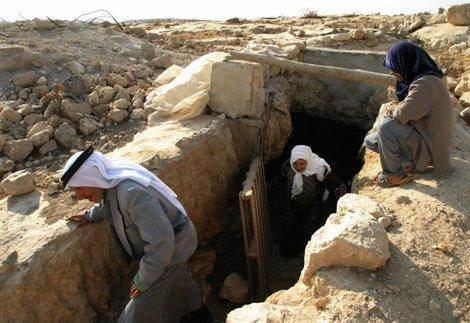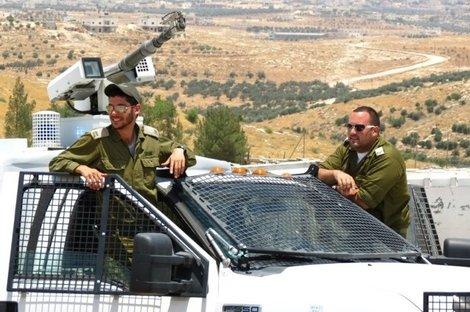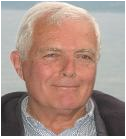| DEAR BUBBAS AND BUBBETTES, One of the greatest current tragedies on planet Earth is our unwillingness to recognize the horror of what is taking place every day in this metaphysically iconic land. Who really gave this land to whom, and on what real justification can those whose families have lived here for so many centuries be expelled and made homeless today? Can religion really be the reason?? Or are there other factors lurking here that need to remain unmentionable? What do you think about this? All the very best and take care, Andy | ‘I AM AN ILLEGAL ALIEN ON MY OWN LAND’ By David Shulman, NYRB, 17 July 2012. A Palestinian couple inspecting their former cave dwelling in Susya following an earlier expulsion, September 6, 2004 In 1949, shortly after Israel’s War of Independence, S. Yizhar—the doyen of modern Hebrew prose writers—published a story that became an instant classic. “Khirbet Khizeh” is a fictionalized account of the destruction of a Palestinian village and the expulsion of all its inhabitants by Israeli soldiers in the course of the war. The narrator, a soldier in the unit that carries out the order, is sickened by what is being done to the innocent villagers. Here he is in Nicholas de Lange and Yaacob Dweck’s translation (Ibis Publications, 2008): I felt a terrifying collapse inside me. I had a single, set idea, like a hammered nail, that I could never be reconciled to anything, so long as the tears of a weeping child still glistened as he walked along with his mother, who furiously fought back her soundless tears, on his way into exile, bearing with him a roar of injustice and such a scream that—it was impossible that no one in the world would gather that scream in when the moment came…. Still, the narrator goes along with the expulsion without overt protest. Yizhar himself was an intelligence officer during the war; he describes events he may well have seen himself: “We came, we shot, we burned; we blew up, expelled, drove out, and sent into exile. What in God’s name were we doing in this place?” Somewhat surprisingly, this story was taught for many years in Israeli secondary schools as part of the modern Hebrew canon; even today it is still on the books as an optional text for the matriculation exam (unless the Netanyahu government has secretly removed it). The story embodies the conscience of Israel at the moment of the state’s formation. It also gives voice to a much older Jewish tradition of moral protest and the struggle for social justice. When I was growing up in the Midwest in the 1950s and 1960s, I mistakenly thought that this tradition was at the core of what it meant to be Jewish. A Susyan woman holding an Israeli demolition order, June 2012 Sixty-three years have passed since Yizhar wrote “Khirbet Khizeh.” I wish I could say that what he described was an ugly exception and that such actions don’t happen any more. It is not, and they do. This week I find myself in Susya, in the South Hebron hills, near the southern corner of the West Bank. Like their counterparts in many other Palestinian villages, Susya‘s approximately 300 inhabitants are impoverished, badly scarred, terrified, and defenseless. The week before last the officers of the Civil Administration, that is, the Israeli occupation authority, turned up with new demolition orders in their hands; these orders apply to nearly all the standing structures in the village—mostly tents, ramshackle huts, sheep-pens, latrines, and the wind-and-sun-powered turbine that Israeli activists put up some three years back to generate electricity on this stony, thirsty hilltop in the desert. If the orders are carried out—this could happen at any moment—then it means the nearly complete destruction of an entire village and the violent expulsion of its people. They will be, quite literally, cast into the desert. Not, however, for the first time. Depending on how you count them, there have already been three, perhaps four, expulsions at Susya. The first one happened in 1986, when Palestinian families—over 1500 people— were driven from their homes in Susya al-Qadima, “Old Susya,” which sat on top of an archaeological site that, to their misfortune, contained a second-Temple-period synagogue. They took up residence at a site nearby, on lands belonging to them, called Rujum al-Hamri, which happened to be close to the new Israeli settlement of Susya (established in 1983). The new settlers, put there by the state, were not good neighbors. In fact, for the last nearly three decades they’ve done whatever they could to drive the Palestinians out—including many violent, sometimes murderous attacks on them, continuous harassment, and efforts to use the courts, both military and civil, against them. Together with several of my colleagues, I myself have had the honor of being brutally assaulted by Susya settlers. A tent in Susya that may soon be demolished by Israeli authorities, June, 2012 The second expulsion took place in 1990, when Rujum al-Hamri was evacuated by the army. The inhabitants were loaded onto trucks, exactly as in Yizhar’s story from 1949, and driven some fifteen kilometers north, where they were dumped by the roadside at the edge of the desert. Still, most of them came back, building the encampment of present-day Susya on a rocky escarpment within their historic agricultural and grazing grounds. Their daily life—I can tell you from long first-hand experience—is a fierce struggle to survive in this arid land in the face of a hostile system that has devoured most of their property, destroyed the caves they lived in, and still subjects them to arbitrary arrest, humiliation, and life-threatening violence. They are poor, poorer than anything I have ever seen in India; what they have are their sheep and goats and a few sun-baked fields where they grow a low-grade variety of wheat and barley that serve as fodder. Because they have been robbed of their wells, they have to buy water from the nearby city of Yatta, which is delivered in small tankers. The third expulsion took place in July 2001, when civilians—undoubtedly settlers—worked side by side with Israeli soldiers to destroy the tattered tents and shacks and drive the Palestinians out, apparently in response to the murder of a well-known settler, Yair Har Sinai (the Susyans had nothing to do with this). Again they came back and rebuilt. But Israeli Susya has continued to expand, spawning a series of so-called “illegal outposts,” all of them on Palestinian land, even as the Palestinian shepherds and farmers have been hemmed into a continually shrinking space. The coup de grâce may be delivered in the next few days—unless we manage to forestall it. Earlier this year, in February, a settlers’ NGO called “Regavim” (literally “clods of soil”--the name aptly represents the romantic fantasy of belonging that settlers typically cultivate), petitioned the Israeli Supreme Court, demanding that demolition orders issued years ago by the Civil Administration for Palestinian Susya be carried out immediately. The petitioners, many of whom live on stolen land, had the temerity to refer to Palestinian Susya, the last remnant of the ancient village, as an “illegal outpost.” The court held a hearing on June 6 and issued an order prohibiting all further building in Palestinian Susya. In itself, this makes little difference; it is anyway next to impossible for Palestinians living in Area C of the West Bank, under direct Israeli control, to get a permit to build from the committee, largely composed of settlers, that oversees such requests. But the Court’s preliminary ruling seems to be linked to the new demolition orders, for reasons not yet clear. Perhaps the Civil Administration sees the court order as an opportunity to act with impunity against Palestinian Susya. Perhaps the Court itself is trying to restore a balance after having ruled recently against the settlers in Beit Ulpana, a suburb of the huge central West Bank settlement of Beit El. (The Beit Ulpana houses, all illegally built, will apparently be sawed off their foundations and moved a few hundred meters to another piece of appropriated Palestinian land.) Israeli soldiers in a vehicle with an anti-riot "Skunk" gun, Susya, June 22, 2012 Susya is a microcosm of the Israeli occupation, a lucid embodiment of its norms and habits. Only the scale of the planned expulsion is a little unusual; normally the process, though relentless, proceeds in smaller steps. Note that the legal aspect of the situation, which I’ve only outlined, is little more than a superstructure, one might even say a distant theory; on the ground what one sees is a refined form of human malevolence, incapable of justification in rational terms. The Israeli army, the police, the bureaucrats of the Civil Administration, the government, the cabinet, the Knesset, the military and civilian courts, and large parts of the Israeli press—all are deeply implicated in an act, or a series of acts, of gratuitous violence inflicted on innocent human beings, in broad daylight. No one should pretend that any of this is anything but a crime. Perhaps the sheer magnitude of the impending injustice, and the particular resilience and courage shown by the Susya Palestinians over the years, can explain the impressive response to the call for a major protest at Susya on June 22. I’ve rarely seen so large, so disciplined, and so clearly focused a peace demonstration. Over 500 people came from Jerusalem (including a large Palestinian contingent from East Jerusalem), Tel Aviv, Beer Sheva, and various sites in the occupied West Bank. For once, there were no rambling speeches rehearsing the terrible tale. Within minutes of arrival, we were marching under a scorching sun toward Susya al-Qadima, the original site of the village, now off limits to Palestinians. The Susya people were going home. It was a moving sight, and a certain solemnity, even serenity, accompanied us as we walked through the thorns and rocks. There was not the least hint of violence; no stone was thrown. Of course, the army was waiting for us, and the soldiers, too, lost no time in doing what soldiers do. There were stun grenades, which can make you deaf for a few days if they go off close to you, and tear gas, and the usual threats and shouts and orders barked at us by senior officers. None of this stopped us. Much more ominous was the Israeli army’s Doomsday Weapon, the Bo’esh or Skunk, which sprays a liquid of overpowering stench that sinks into your pores and clothes and stays there for days; it causes severe vomiting and very effectively stops a crowd of marchers. I’ve never experienced it, but there are activists who describe it as worse than the rubber-coated bullets the army likes to shoot at Palestinian demonstrators. The Skunk sits atop a long, ugly military vehicle, and it has a turret that swivels back and forth, taking aim at whoever it wants to attack. It’s a little unnerving when the turret targets you. But even the threat of the Bo’esh didn’t deter the demonstrators, who faced a line of heavily armed soldiers, guns loaded. “Let them spray me,” said one of the Palestinians to me, smiling; “I don’t care; anyway it’s a stinking occupation.” As in other Palestinian villages I’ve seen in this mode of non-violent protest, at Susya the women had a leading part, fearlessly engaging the soldiers, taunting them, dancing and singing before them, insouciant. Alongside these women was a troupe of five brightly costumed clowns, no less daring and inventive. Imagine a soldier, laden down with helmet and cartridges and grenades and boots and all the other foolish bits of metal and plastic, pouring sweat in the midday sun. What, exactly, is this soldier to do when a clown with a bright red nose, cackling and giggling, sticks a peacock’s feather down the muzzle of his sub-machine gun and then proceeds to tickle his nose? Protesters in clown suits confronting Israeli soldiers, Susya, June 22, 2012 I wondered, as I often do at such moments, if any of the soldiers standing there in the Palestinian fields felt as ridiculous as they looked to us. And why were they there? Maybe to make sure we didn’t march on the Israeli settlement of Susya, just over the hill? Was this what really terrified them? But we had no intention of trying this. Still, I said to my friend Danny, maybe one day this will happen, and everything will change. I’d told him just moments before that I had good news; last night just after midnight a granddaughter was born. He laughed: “Your granddaughter will live to see that day.” But I don’t think it will take that long. Meanwhile, what will happen in Susya next week, and the week after that? The protest is spreading, no doubt about that, but the danger of expulsion remains very real. Here is Nasser Nawaja’, 28 years old, one of the leading activists in Susya and a close friend, speaking to the Hebrew press: They’re calling our village an illegal outpost. These lands are ours from before there was a State of Israel. My father is older than your state—and I am an illegal alien on my own land. I ask where is justice? Your courts distinguish between the settler and the Palestinian…We’re surrounded by illegal outposts [built by settlers] that have everything—infrastructures of water and electricity— despite the fact that these settlements are illegal even under Israeli law. And now you want to expel this old man from his home once again? To expel all of us who own these lands, who have lived on them for generations in this space that is ours, which is all we know? June 28, 2012, 5 p.m. |






 RSS Feed
RSS Feed